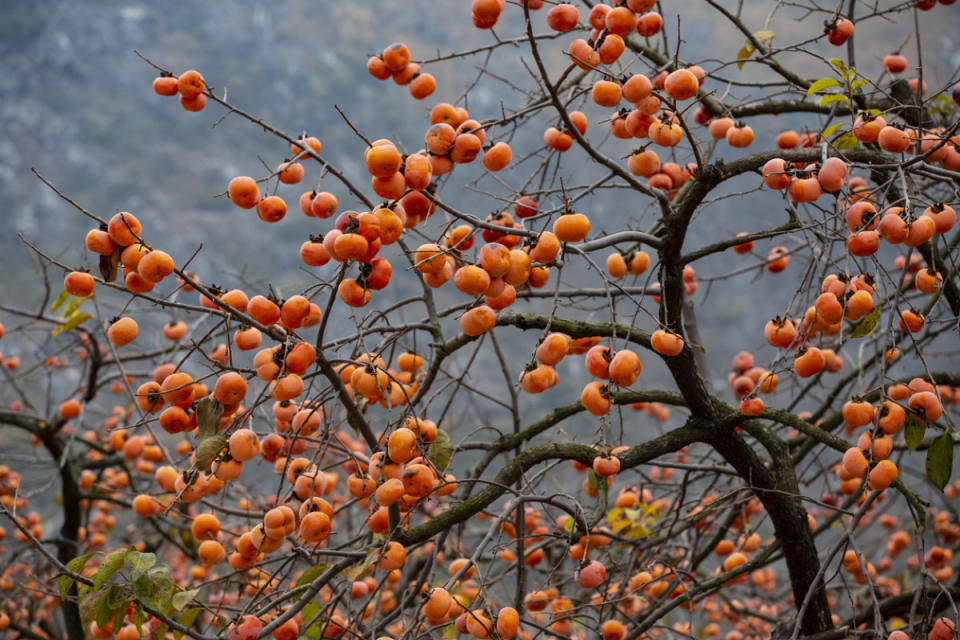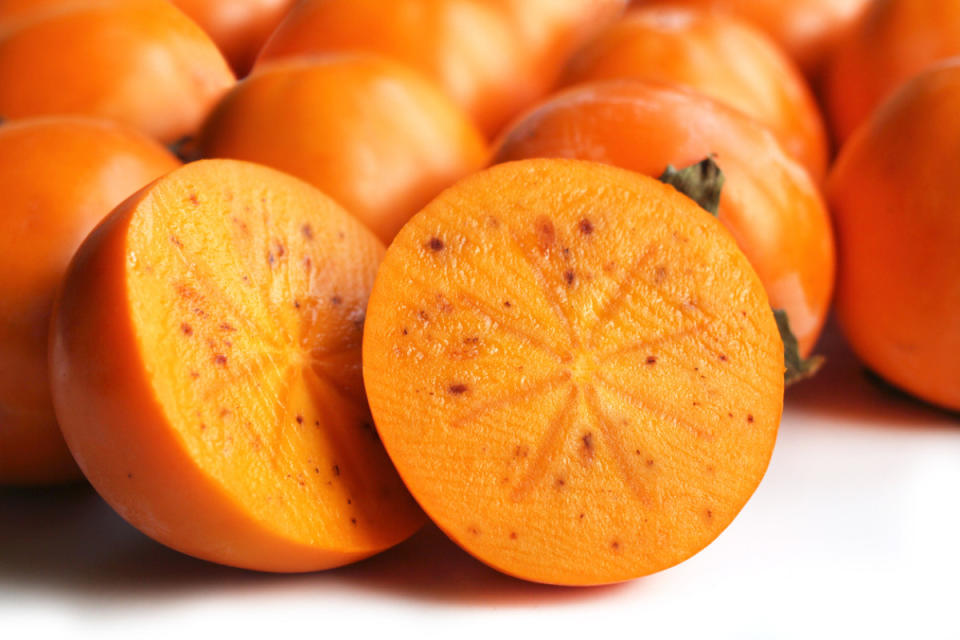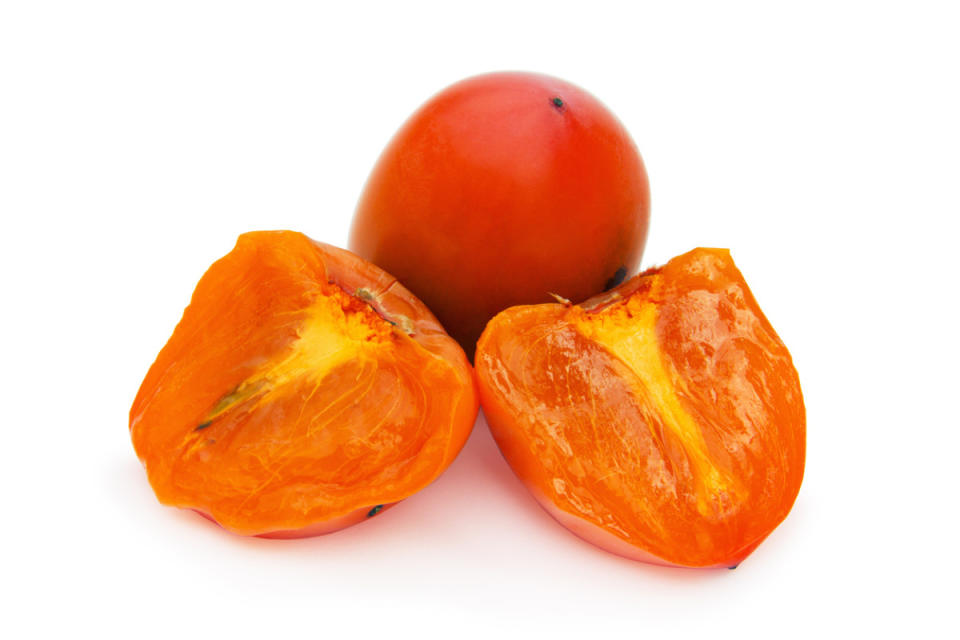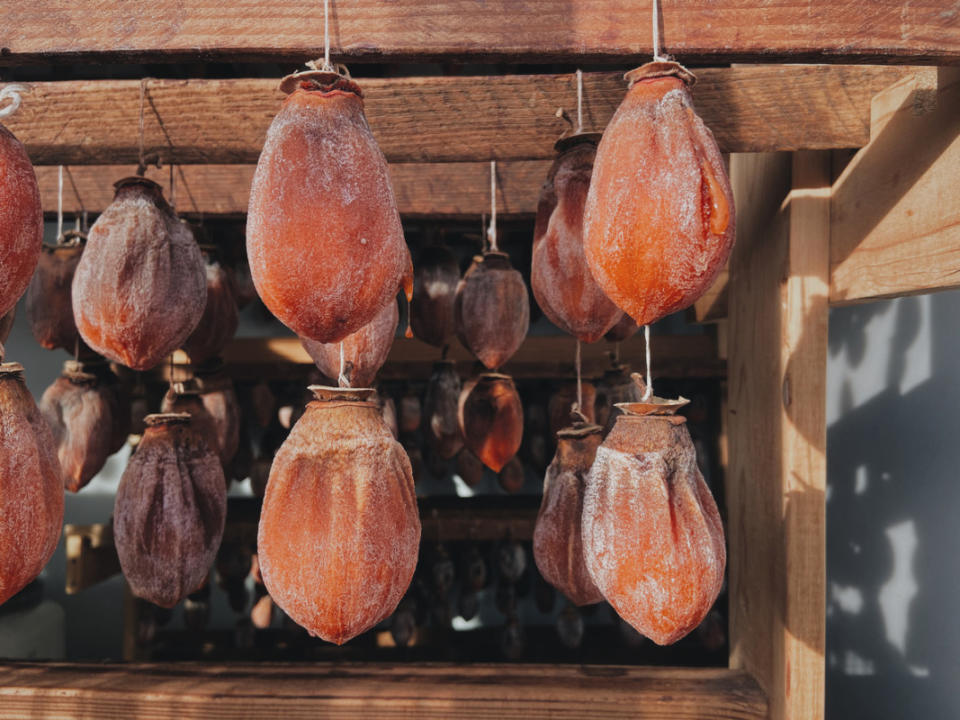All About Persimmons: Everything You Need to Know About the Delicious Fall Fruit, According to Chefs

An array of ripe persimmons
Now that it's finally starting to feel like autumn and there's a chill in the air, we're in full fall mode. Tomato girl summer definitely had a moment, but it's about to be granola girl fall, and we're here for it. Bring on sweater weather, PSLs and all the leaf-peeping weekends.
We're also here for all the fall fruit. Apples and pears may get a lot of love this time of year, but there's another seasonal treat that you shouldn't overlook: persimmons. The orange fruit comes in many varieties, all of which have their charms, and they're only around for a few months, so now's the time to give them a try.
If you're looking for a pick-your-own experience, that might be tricky (unless you live in the South or Asia), but the good news is that many specialty markets and even mainstream grocery stores have begun stocking the ochre-hued fruit.
We talked to chefs to gather all the need-to-know persimmon info, including details on all the different varieties, how to tell when persimmons are ripe, what persimmons taste like, the best recipes for each persimmon type—and much more. Read on for our complete guide to persimmons.
Related: Persimmon is the New Black: 8 Fun Persimmon Recipes

iStock
What Are Persimmons?
Persimmons are an orange fruit that grows on trees in Asia and in some southern states here in the U.S. Aside from their size, where they grow and their flavor, the other big difference between Asian (Diospyros kaki) and American (Diospyros virginiana) persimmons is their astringency, according to Damon Campbell, the executive chef at Fairmont Pacific Rim in Vancouver, BC. "American persimmons are astringent when unripe but very sweet and soft when ripe; Asian persimmons can be either non-astringent (sweet but firm when ripe) or astringent," he says.
When Are Persimmons in Season?
The peak season for persimmons is fall and winter, so you'll start to see this autumnal fruit popping up on produce stands around early October all the way through January.

iStock
What Are the Most Common Persimmon Varieties?
At the market, you'll typically find two Asian persimmon varieties: Fuyu and Hachiya.
• Fuyu persimmons are short and round and look a bit like an orange tomato. The non-astringent variety has wide leaves on top and a flat bottom. Most Fuyu persimmons have no seeds or very small seeds.
• Hachiya persimmons, an astringent variety, are longer than Fuyus and have a tapered shape that is somewhat reminiscent of a Roma tomato. Like Fuyus, Hachiyas are seedless or nearly seedless.
• American persimmons, another astringent variety, are more difficult to find because they aren't widely grown, can be hard to transport and don't have a long shelf life. If you live in an area where American persimmons are grown, ask someone at your local farmers' market where to find them.
At the grocery store, you might notice that both Fuyus and Hachiya are simply labeled "persimmons." Fuyus and Hachiya are quite different, so if you need help figuring out which persimmon variety you're looking at, just ask someone who works in the produce department.

iStock
How Do You Know When a Persimmon Is Ripe?
Fuyu and Hachiya persimmons are similar to tomatoes and plums in the sense that they're firm when unripe and much softer, a bit squishy even, when they're super ripe. "Depending on the variety you get, you definitely shouldn’t eat any of them while they are hard," advises Mat Urban, executive chef at CBD Provisions at The Joule in Dallas. "Fuyu persimmons are the most common variety you will find in stores and should be eaten when they are between soft and very soft; however, with Hachiya persimmons, you’ll almost want them to be mushy ripe."
Another indicator of ripeness is color. While unripe persimmons have paler, green skin, ripe persimmons have deep, saturated color. "Some experts claim that a little streak of black on the skin of Hachiya persimmons indicates an especially sweet piece of fruit," shares Campbell. "In fact, if you’re looking for already-ripe Hachiyas, you’ll often see some black staining on the skin."
What Do Persimmons Taste Like?
While they may look like a tomato or resemble a plum, persimmons have a flavor all their own, which is why chefs love them so much. Campbell says that Hachiyas and Fuyus have a mild flavor, similar to that of honey, while Urban notes that American persimmons, specifically those grown near Dallas, can have a pumpkin pie-like flavor. "Think of very mild fall spices, but also with hints of cherry and apple," he adds.

iStock
How to Eat Persimmons
The versatile persimmon can be eaten in many ways. How you prepare them depends on the variety.
Because they're not astringent, Fuyu persimmons are great eaten fresh. You can slice them thinly and toss them into salads or chop them finely and use them in a salsa. You can peel them or leave the skin on. They're also a fun addition to a cheese board. If you slice them into rounds they have a pretty flower-like pattern. Fuyus are also a good choice for making quick breads.
A fully ripe, soft Hachiya persimmon is perfect for making persimmon pudding or freezing into persimmon sorbet. If she has extra squishy Hachiya persimmons on hand, Naiha Falkner, chef de cuisine at plant-based meal delivery company Thistle, likes to scoop the insides out to make a custard-like fruit purée. "It's an excellent autumnal addition when blended into smoothies or yogurt bowls," she says. Not letting any sweet stuff go to waste, she uses the pulp in bread recipes, cinnamon roll filling or for a caramel-like sauce to top fall desserts. Because Hachiya persimmons are eaten very ripe, you want to scoop out the pulp and discard the skin.
Campbell likes to use persimmons to create a vinaigrette or emulsified salad dressing, but he says you can also create a persimmon glaze for chicken or pork by reducing their juice with a sweetener such as honey, agave or sugar.
"At CBD, we use persimmons to make a persimmon BBQ sauce," shares Urban. "However, I think the most unique way they are used is for hoshigaki (Japanese dried persimmons)." This method involves peeling Hachiya persimmons and hanging them by their stems in a warm, dry place for up to six weeks, then massaging them to break up the pulp inside, releasing their natural sugars. "When they are finished, they look like they’ve been dipped in powdered sugar due to all of the sugars crystalline on the flesh," he says.
How to Store Persimmons
Like avocados, persimmons should be kept on the counter at room temperature until they ripen Once ripe, they should be consumed within 1-2 days, or they go bad quickly, says Urban. "Storing unripe persimmons in the fridge will drastically slow the ripening process, allowing you to pull a few out at a time to let them ripen that way." Need your persimmons to ripen quickly? Stash them in a paper bag and add an apple or banana to help speed up the process.
What's This About Persimmon Seeds and Predicting the Weather?
You might have heard some folklore tales about the look of an American persimmon seed and its correlation to winter weather. If you can get your hands on an American persimmon, it's a fun and easy thing to do. Just halve the fruit, cutting through the seed in the center. The shape of the seed is said to indicate what the winter weather will be like.
• If the seed looks like a fork, it will be a mild winter.
• If the seed looks like a spoon, there will be lots of snow.
• If the seed looks like a knife, it will be bitterly cold and the wind will cut like a knife.
Up next, Meet the 25 healthiest fruits—from berries to bananas.

